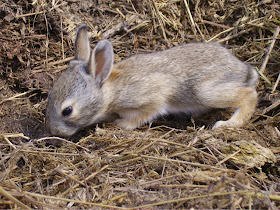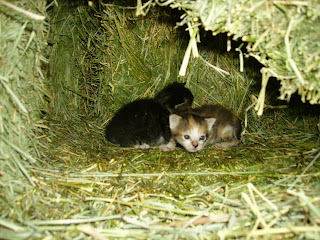
Got Milk for me? The chorus of goat's bleating and the calf mooing seem to ask while they peer through the fence into the shed where the sound of milk splashing against the sides of a stainless steel bucket draws their attention. When the milk pail is full, I pour it into a tote and wait for
Pudge, the first goat to be milked, to finish her grain.
 Pudge
PudgeShe then jumps off the stand and Chicory, the next dairy goat, files in to the shed on her own and only gets as far as placing her front feet on the stand - then waits. I push gently on her hips but she plants her feet and doesn't budge so I place my arms around her flanks and lift while she scrambles with her back feet. We've progressed. She doesn't ram her head into the metal front of the stand, but only occasionally, and her back legs don't do the splits with one sliding off the stand to the left and the other to the right. But, its far from graceful, and though she watches the other two goats morning and night leap onto the stand, she's yet to catch on. It's okay, yearlings are all ding bats and when she's two she'll have grown up into an intelligent goat, I hope. Until then, she's part of the entertainment committee and much patience on our part is needed.

Chicory
While Chicory searches the feed bowl for any crumbs left by
Pudge, I scoop up my premixed combination of beet pulp, vitamins, sunflower seeds, and COB (corn, oats and barley) and refill the dish. Milking Chicory doesn't take long as it will be another year or two before she's producing large quantities of milk.

Leta
Last up is sweet, complacent Leta who puts her front feet onto the stand, heaves her weight forward, then settles back, forward, then back at least ten times while I shout encouragingly, " Hut! Hut! Hut!". If I'm not playing my
cheer leading role, she stops and peers around at me with a questioning glaze, refusing to budge until I get out my pom poms so to speak. Then after she jumps up, I tell her,"Good Girl!" and she wags her tail like she's done something really grand. I'm never sure whether to roll my eyes or laugh but when I'm in a hurry, I'd like to bean her over the head for taking so long.
In the twenty-four years we've been raising dairy goats, we've never had one quite like Leta. She takes the grip of an iron man to extract milk from her teats but her sweet personality and large milk production has kept her in our herd, if you can call three goats a herd.
If I dare to arrive late to do chores, oh the tongue lashing I receive. The kids and calf tell me in a near deafening pitch of how they almost starved to death waiting on me. The milking does get a panicked look in their eyes as their bleats raise to a loud insistent screaming pitch as they try to convince me that their udder nearly burst while I was off lolly-gagging around instead of doing my job. When I unlatch their pen's gate, order is forgotten as they push and shove each other trying to be the first one out and onto the milking stand. The whole melodramatic scene would make me laugh, if it didn't make me feel so guilty. I nursed our three children and I know how uncomfortable the milking does are feeling. Though in reality, if they became too full they would begin to drip milk and then the drip would turn into a stream but the udder would not burst.
The great advantage to milking goats over a milk cow is no manure encrusted tail swishing in your face, you aren't bent over since the goats are up on a stand and you've a gallon to milk not four. The same method of extracting milk from a cow is used to obtain it from a goat. You reach under their flank and encircle a teat with your thumb and forefinger squeezing to prevent the escape of milk upward into the udder and then pretend you are playing rapid scales on a piano by compressing your middle finger, ring finger, and then
pinkie if the teat is that long.
Your hands form a rhythm with one squeezing and the other letting go enough to allow the milk from the udder to flow into the teat, then it squeezes while the other hand lets go. Pulling downward as you milk is a unpopular move with our girls, and quite unnecessary, thereby avoided.

The faster you milk the more foam forms on the top.
It has been two weeks since our white older does ( a female dairy goat) have kidded (had their kids). They will soon reach their full milking potential of close to a gallon a milking or two gallons a day. The Nubian (brown goat with floppy ears) named Chicory is just a yearling and it will be a year or two more before she will reach the production levels of our seven and nine year old does, Leta and
Pudge. Sound like a lot of milk? It is. Our girls are heavy producers.
Hay isn't cheap and why waste money on a animal that won't give much in return? So we choose our goats carefully and monitor our feed program.
We feed little grain in order to more closely balance the omegas in the milk. In comparison the stores milk can be as bad as 15 omega 6's to 1 omega 3 which causes high cholesterol and a host of other health problems. Where as one study sited women who drank a large amount of omega balanced milk lowered their risk of breast cancer 60 percent.
The advantage of goat's milk over cow's milk is that goat's milk has smaller fat globules and is therefore easier to digest. It was the reason why we bought goats in the first place as our children, when small, could not tolerate the stores milk and I suspected it was the cause of my runny nose. It was and we found it didn't matter if it was fresh cow's milk or the store's product. They both caused us problems. Our goat's milk has all the digestive enzymes present since it is not
pasteurized and during the first hour after milking has an extremely high
antibacterial content. A win win situation as far as we were concerned.
I won't quote anymore facts as you might be already saying that I'm a walking Encyclopedia, which is what my friends affectionately call me. But, the question remains. Are you sold on goat's milk yet?
































